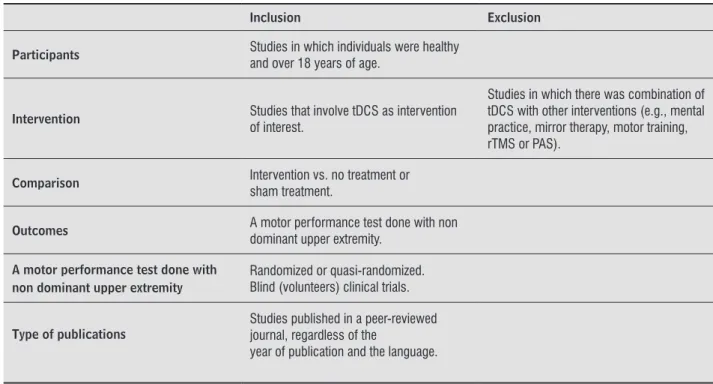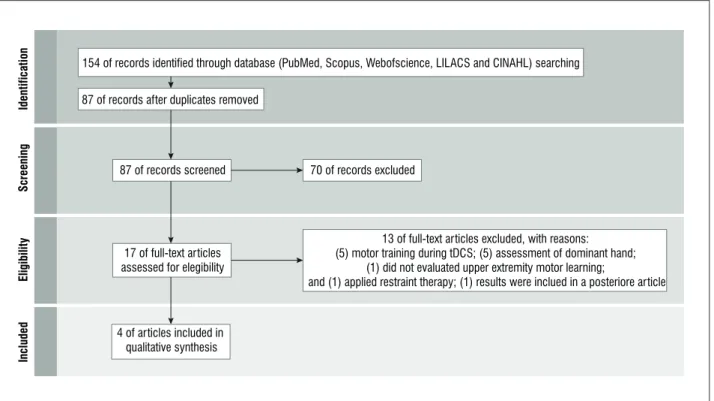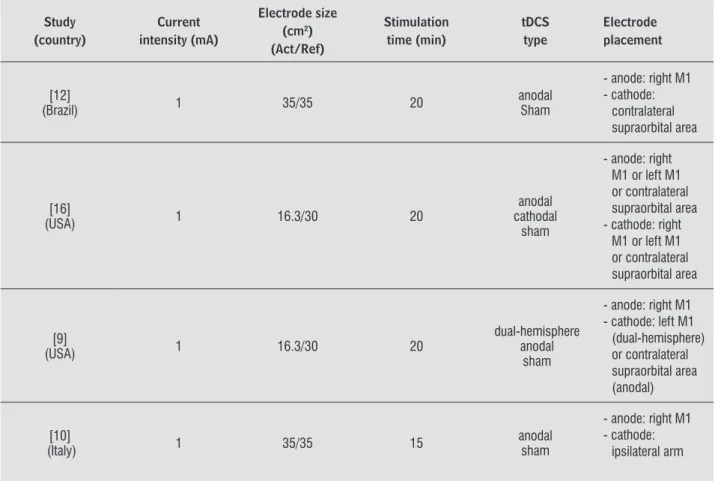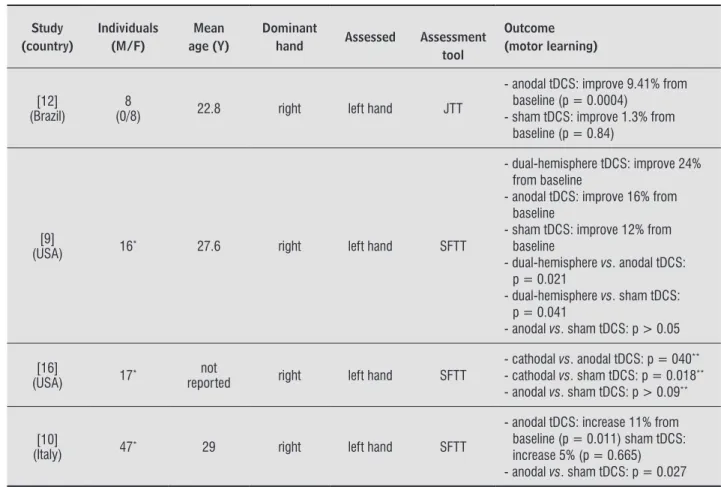Fisioter. Mov., Curitiba, v. 28, n. 1, p. 159-167, Jan./Mar. 2015 Licenciado sob uma Licença Creative Commons DOI: http://dx.doi.org.10.1590/0103-5150.028.001.AR01
[T]
Effects of transcranial direct current stimulation on motor
learning in healthy individuals: a systematic review
[I]
Efeitos da estimulação transcraniana por corrente contínua
no aprendizado motor: uma revisão sistemática
[A]
Águida Foerster, Sérgio Rocha, Maria das Graças Rodrigues Araújo, Andrea Lemos, Kátia Monte-Silva*
Universidade Federal de Pernambuco, Recife, Brazil
[R]
Abstract
Introduction: Transcranial direct current stimulation (tDCS) has been used to modify cortical excitability and promote motor learning. Objective: To systematically review published data to investigate the effects of transcranial direct current stimulation on motor learning in healthy individuals. Methods: Randomized or quasi-randomized studies that evaluated the tDCS effects on motor learning were included and the risk of bias was examined by Cochrane Collaboration’s tool. The following electronic databases were used: PubMed, Scopus, Web of Science, LILACS, CINAHL with no language restriction. Results: It was found 160 studies; after reading the title and abstract, 17 of those were selected, but just 4 were included. All studies involved healthy, right-handed adults. All studies assessed motor learning by the Jebsen Taylor Test or by the Serial Finger Tapping Task (SFTT). Almost all studies were randomized and all were blinding for participants. Some studies presented differences at SFTT protocol. Conclusion: The result is insufficient to draw conclusions if tDCS influences the motor learning. Furthermore, there was significant heterogeneity of the stimulation
* AF: MSc, e-mail: foerster.as@gmail.com SR: MSc, e-mail: srocha3105@gmail.com
MGRA: PhD, e-mail: mgrodriguesaraujo@hotmail.com AL: PhD, e-mail: andrealemos4@gmail.com
160
parameters used. Further researches are needed to investigate the parameters that are more important for motor learning improvement and measure whether the effects are long-lasting or limited in time.
[P]
Keywords: Electric stimulation. Learning. Neuronal plasticity. [B]
Resumo
Introdução: A estimulação transcraniana por corrente contínua (ETCC) tem sido usada para modificar a exci -tabilidade cortical e promover o aprendizado motor. Objetivo: Revisar sistematicamente os dados publicados para investigar os efeitos da estimulação transcraniana por corrente contínua sobre o aprendizado motor em indivíduos saudáveis. Métodos: Foram incluídos estudos randomizados ou quase randomizados que avaliaram os efeitos da ETCC sobre o aprendizado motor. O risco de viés foi avaliado por meio da ferramenta Cochrane Collaboration. As seguintes bases de dados eletrônicas foram utilizadas: PubMed, Scopus, Web of Science, LILACS, CINAHL, sem restrição de idioma. Resultados: Foram encontrados 160 estudos. Depois de ler o título e o resumo, 17 deles foram selecionados, mas apenas 4 foram incluídos. Todos os estudos envolveram adul-tos saudáveis e destros e avaliaram o aprendizado motor por meio do Jebsen Taylor Test ou do Serial Finger Tapping Task (SFTT). Quase todos os estudos foram randomizados e todos foram cegos para os participantes. Alguns estudos apresentaram diferenças no protocolo do SFTT. Conclusão: O resultado é insuficiente para tirar conclusões se a ETCC influencia o aprendizado motor. Além disso, houve uma significativa heterogeneidade dos
parâmetros de estimulação utilizados nos estudos. Futuras pesquisas são necessárias para investigar quais são os parâmetros mais importantes para a melhoria do aprendizado motor e medir se os efeitos são duradouros ou limitados ao longo do tempo. [K]
Palavras-chave: Estimulação elétrica. Aprendizado. Plasticidade neuronal.
Introduction
Since transcranial direct current stimulation (tDCS) was introduced by Nitsche and Paulus in 2000, it has been used to modify cortical excitability in a non-invasive and painless way (1, 2). Furthermore, tDCS has been shown to be effective for promoting motor learning in healthy subjects (3-5) and patients with brain disorders (6-8).
Modulating externally the brain excitability with the proposal of understand the mechanisms involved in motor learning has been largely employed in the last decade (9-16). Electrophysiological data demon-strate that changes of neuronal activity and excitabil-ity accompany the learning of new motor skill (17). As improving motor learning is the aim the therapy of many neurological and musculoskeletal conditions, tDCS has been pointed out as a therapeutic promise for enhancing clinical outcomes in these conditions (18). However, it is known that tDCS modulate the brain activity specific to the polarity, location of ap -plication and other parameters of stimulation (e.g. duration, intensity, size of electrode) (1, 14, 19). Then,
before using it in clinical practice, it is crucial to de-termine the best stimulation parameters required to increase motor learning, as well as to consider the effective ability of tDCS to improve motor learning.
Here, the studies addressing the effects of tDCS on motor learning over the non-dominant upper limb motor function in healthy individuals were system-atically reviewed. Furthermore, the purpose of the current review was to investigate the parameters of stimulation recommended in these studies.
Methods
Literature research and Selection criteria
A literature research was performed using the fol-lowing databases: PubMed, Scopus, Web of Science, LILACS, CINAHL, from their inception to January 2014.
161 Risk of bias assessment
The Cochrane Collaboration’s tool (Reviewer’s Handbook version 5.1.0) was used to assess the risk of bias of the included studies. Through five items, this tool evaluates selection, execution, detection and publication bias. In each item the evaluator considers a low, unclear or high risk of bias. In this system-atic review, for each methodological procedure the “low risk of bias” was considered when the authors cited the item above the text, “high risk of bias” when the authors report that did not perform it and “un-clear risk of bias” when it was not “un-clear whether it was done.
Data extraction
The following data relevant to the aims of this study were extracted: (1) study design; (2) char-acteristics of subjects; (3) outcome measures and tDCS parameters; and (4) mean ± standard devia-tion (SD) of motor outcome before and immediately post intervention. Given the purpose of this review, only the data of non-dominant upper extremity were extracted.
‘healthy subjects’, and any other associated variation. These terms were used in various combinations to find relevant studies. In addition to searching the da -tabase, the reference lists of all retrieved papers were searched for any related publications unidentified by the initial search strategy.
Two reviewers (AF and SR) screened independent-ly the title and abstracts identified from the database research to assess whether they met the predefined inclusion criteria. The inclusion and exclusion criteria are listed in Table 1. Full text articles from the poten-tially relevant studies were reviewed to determine the studies to be included in the review. Differences of opinion between reviewers were resolved by consult-ing the opinion of a third reviewer (KMS).
Outcome measures
Randomized and quasi-randomized controlled clinical trials that evaluated the effects of tDCS on motor learning as primary or secondary outcome measures were included. The motor learning had to be assessed by a performance motor test done with non dominant upper limbs before and after tDCS, i.e., “off-line” studies.
Table 1 - Criteria for considering studies for the review
Inclusion Exclusion
Participants Studies in which individuals were healthy and over 18 years of age.
Intervention Studies that involve tDCS as intervention of interest.
Studies in which there was combination of tDCS with other interventions (e.g., mental practice, mirror therapy, motor training, rTMS or PAS).
Comparison Intervention vs. no treatment or sham treatment.
Outcomes A motor performance test done with non dominant upper extremity.
A motor performance test done with non dominant upper extremity
Randomized or quasi-randomized. Blind (volunteers) clinical trials.
Type of publications
Studies published in a peer-reviewed journal, regardless of the
year of publication and the language.
162
studies presented selective reporting of outcomes (9-10, 12, 16).
TDCS protocol
The stimulation parameters of tDCS varied among studies and are summarized in Table 2. All studies included used stimulation intensity of 1mA and time duration over 15 min. The parameters of electrode size and tDCS type were heterogeneous among the studies. The cortical area stimulated was the primary motor cortex (M1) in all studies.
Overview of included studies
Table 3 shows the main characteristics of the studies included in the systematic review. In sum, 85 healthy, right-handed adults were evaluated. Sham treatment was given to 63 patients and 63 patients were submit-ted to active tDCS. All studies verified improvement in motor performance of non-dominant hand and in-vestigated the upper extremity dominance was by the Edinburgh Handedness Inventory a sufficient means of assessment of the handedness aspect (20).
Results
Identiication and selection of studies
The literature research of on-line databases iden-tified 160 studies. After removal of the duplicates, the research yielded 87 citations. After the exclu-sion based on title and abstract, 17 potentially rel-evant articles were obtained and evaluated by two independent reviews (AF and SR), and five papers that met our eligibility criteria were analyzed. Two papers (15-16) resulted of the same study and the results obtained in one of them (15) were shown in the other (16) with a larger sample, so four studies were considered and included (Figure 1).
Risk of bias
All studies showed more than one type of bias (Figure 2). Just one study did not perform random-ization (10) and all of them failed in reporting the concealment of treatment allocation (9, 10, 12, 16). Two studies did not mention if the evaluators were blinding (9, 16). Three studies failed in reporting if the outcome assessor was blinding (10, 12, 16). All
Figure 1 - Flowchart for the selection of studies Note: tDCS = transcranial direct current stimulation.
Iden
ti
fi
ca
ti
on
Scre
enin
g
Eligibil
it
y
In
cl
ud
ed
87 of records after duplicates removed
154 of records identified through database (PubMed, Scopus, Webofscience, LILACS and CINAHL) searching
87 of records screened
17 of full-text articles assessed for elegibility
70 of records excluded
13 of full-text articles excluded, with reasons: (5) motor training during tDCS; (5) assessment of dominant hand;
(1) did not evaluated upper extremity motor learning;
and (1) applied restraint therapy; (1) results were inclued in a posteriore article
163
Table 2 - Parameters of tDCS protocol of the included studies
Study (country)
Current intensity (mA)
Electrode size (cm2)
(Act/Ref) Stimulation time (min) tDCS type Electrode placement [12]
(Brazil) 1 35/35 20
anodal Sham
- anode: right M1 - cathode:
contralateral supraorbital area
[16]
(USA) 1 16.3/30 20
anodal cathodal
sham
- anode: right M1 or left M1 or contralateral supraorbital area - cathode: right
M1 or left M1 or contralateral supraorbital area
[9]
(USA) 1 16.3/30 20
dual-hemisphere anodal
sham
- anode: right M1 - cathode: left M1
(dual-hemisphere) or contralateral supraorbital area (anodal)
[10]
(Italy) 1 35/35 15
anodal sham
- anode: right M1 - cathode:
ipsilateral arm
Note: Act = active; Ref = reference; min = minutes; tDCS = transcranial direct current stimulation; M1 = primary motor cortex. Figure 2 - Risk of bias of the included studies by Cochrane Collaboration’s tool
Source: Handbook version 5.1.0 (22).
Ra nd om iz atio n (s el ec tion bi as ) Co nc ea lmen to f treatm en ta llo ca tion (s el ec tion bi as ) Blinding of pa rt icip ants an d ev al ua to rs (e xe cuti on bi as ) Blinding ou tc om ea ssessor (detec tion bi as ) Select iv er ep or ting of ou tc omes (publication bi as )
Low risk of bias
Unclear risk of bias
High risk of bias
Boggio et al. 2006
Vines et al. 2008a
Vines et al. 2008b
-164
Table 3 - Characteristics of included studies
Study (country)
Individuals (M/F)
Mean age (Y)
Dominant
hand Assessed Assessment tool
Outcome (motor learning)
[12] (Brazil)
8
(0/8) 22.8 right left hand JTT
- anodal tDCS: improve 9.41% from baseline (p = 0.0004)
- sham tDCS: improve 1.3% from baseline (p = 0.84)
[9]
(USA) 16* 27.6 right left hand SFTT
- dual-hemisphere tDCS: improve 24% from baseline
- anodal tDCS: improve 16% from baseline
- sham tDCS: improve 12% from baseline
- dual-hemisphere vs. anodal tDCS: p = 0.021
- dual-hemisphere vs. sham tDCS: p = 0.041
- anodal vs. sham tDCS: p > 0.05
[16]
(USA) 17*
not
reported right left hand SFTT
- cathodal vs. anodal tDCS: p = 040**
- cathodal vs. sham tDCS: p = 0.018**
- anodal vs. sham tDCS: p > 0.09**
[10]
(Italy) 47* 29 right left hand SFTT
- anodal tDCS: increase 11% from baseline (p = 0.011) sham tDCS: increase 5% (p = 0.665) - anodal vs. sham tDCS: p = 0.027
Note: M/F = male/female; tDCS = transcranial direct current stimulation; SFTT = serial inger time task; JTT = Jebsen Taylor Hand Functional Hand Test. * Did not report the relation of M/F. ** Study did not report the mean of the results obtained after the intervention.
Only one study (12) assessed the effects of tDCS on motor learning by Jebsen Taylor Hand Function Test (JTT). Three studies (9-10, 16) applied the serial finger tapping task (SFTT). The SFTT required subjects to press four numeric keys on a standard computer keyboard with the fingers, repeating a random or a sequential five element sequence “as quickly and as accurately as possible” for a period of 30s. The numeric sequence was displayed at the top of the screen at all times to exclude any working memory component to the task. Each key press produced a white dot on the screen, forming a row from left to right, rather than the number itself, so as not to provide accuracy feedback. The computer recorded the key press responses, and each 30s trial was automatically scored for the num-ber of complete sequences achieved (speed) and the number of errors made (accuracy) a rest period of 30s between trials was applied (21). One study (10) modi-fied the SFTT and submitted subjects to random and
sequential nine-element series and given an accuracy feedback to the subjects.
Discussion
This systematic review suggests that tDCS affects motor learning process of the non-dominant upper extremity in healthy adults, but it was not conclusive concerning the tDCS parameters (current intensity, electrode size, stimulation time and type) to be ap-plied for this. All studies included presented risk of bias and failed in reveled the effect size of tDCS on motor learning.
165 calculate the effect size of the tDCS making impos-sible to conduct a meta-analysis.
This review showed as limitation the fact of have done the search only in electronic databases, so that potential studies that have not been published on these data bases were not selected for analysis and possible inclusion.
Conclusion
This review suggests that tDCS may affect mo-tor learning mechanisms of the non-dominant hand. However, at the moment, the studies are insufficient to draw conclusions. In addition, all studies presented risk of bias and did not provide necessary information to calculate the effect size of the tDCS. Furthermore, there was significant heterogeneity of the parameters of stimulation used. Therefore, further research is needed to investigate which type of motor learning (explicit or implicit) is most likely to influence, and which stimulation parameters are more important for motor learning improvement. This information will be valuable in guiding future use of tDCS in clini-cal practice.
References
1. Nitsche MA, Paulus W. Excitability changes induced in the human motor cortex by weak transcranial direct current stimulation. J Physiol. 2000;527(Pt 3):633-9.
2. Zaehle T, Sandmann P, Thorne JD, Jancke L, Herrmann CS. Transcranial direct current stimulation of the prefrontal cortex modulates working memory per-formance: combined behavioural and electrophysi-ological evidence. BMC Neurosci. 2011;12:2. doi: 10.1186/1471-2202-12-2.
3. Kantak SS, Mummidisetty CK, Stinear JW. Primary mo-tor and premomo-tor cortex in implicit sequence learn-ing–evidence for competition between implicit and explicit human motor memory systems. Eur J Neu-rosci. 2012;36(5):2710-5.
4. Nitsche MA, Schauenburg A, Lang N, Liebetanz D, Exner C, Paulus W, et al. Facilitation of implicit motor learning by weak transcranial direct current stimula-tion of the primary motor cortex in the human. J Cogn Neurosci. 2003;15(4):619-26.
Selection risk of bias were presented in all stud-ies included, this type of bias refers to systematic differences between baseline characteristics of the groups that are compared. The only strength of ran-domization is that, if successfully accomplished, it prevents selection bias in allocating interventions to participants (22). Two studies (9, 16) did not report if the evaluators were blinding, so, it presented execu-tion risk of bias. In all studies the outcome assessor was not blinding, it is considering a detection risk of bias and could affect the outcome measurements, considering that detection bias refers to systematic differences between groups in how outcomes are de-termined. All studies presented selective reporting of outcomes, setting up a publication risk of bias this type of bias is one of the most substantial biases af-fecting results from individual studies (23).
All studies were homogeneous regarding the pop-ulation evaluated and assessed healthy, right-handed adults. Motor function was assessed by JTT or SFTT, tools recognized in the literature to be effective in measuring motor improvements (21, 24-26).
Two studies modified the original SFTT (9, 16). In these studies an accuracy feedback was given for the subjects during the execution of the task. In general, concurrent augmented feedback has been shown to effectively enhance learning in complex motor tasks (27). In musicians, the auditory feedback reinforced the serial reaction time task, a test similar of the SFTT, performance of the right hand (28). The differences between the results showed in the studies which ap-plied the SFTT could be explained for providing or not accuracy feedback.
166
15. Vines BW, Nair DG, Schlaug G. Contralateral and ipsi-lateral motor effects after transcranial direct current stimulation. Neuroreport. 2006;17(6):671-4.
16. Vines BW, Nair D, Schlaug G. Modulating activity in the motor cortex affects performance for the two hands differently depending upon which hemisphere is stimulated. Eur J Neurosci. 2008;28(8):1667-73.
17. Clark VP, Coffman BA, Mayer AR, Weisend MP, Lane TD, Calhoun VD, et al. TDCS guided using fMRI sig-nificantly accelerates learning to identify concealed objects. Neuroimage. 2012;59(1):117-28.
18. Schabrun SM, Chipchase LS. Priming the brain to learn: The future of therapy? Man Ther. 2012;17(2):184-6.
19. Liebetanz D, Nitsche MA, Tergau F, Paulus W. Pharma-cological approach to the mechanisms of transcranial DC-stimulation-induced after-effects of human motor cortex excitability. Brain. 2002;125(10):2238-47.
20. Oldfield RC. The assessment and analysis of hand -edness: the Edinburgh inventory. Neuropsychologia. 1971;9(1):97-113.
21. Walker MP, Brakefield T, Morgan A, Hobson JA, Stick -gold R. Practice with sleep makes perfect: sleep-depen-dent motor skill learning. Neuron. 2002;35(1):205-11.
22. Higgins J, Altman DG. Assessing risk of bias in included studies. In: Higgins JPT, Green S. Cochrane handbook for systematic reviews of interventions. Chichester; Hoboken: Wiley-Blackwell; 2008. p. 187-241.
23. Dickersin K. Publication bias: recognizing the prob-lem, understanding its origins and scope, and prevent-ing harm. In: Rothstein HR, Sutton AJ, Borenstein M, editors. Publication bias in meta-analysis: prevention, assessment and adjustments. Chichester; Hoboken: Wiley, 2005. p. 11-33.
24. Fregni F, Boggio PS, Mansur CG, Wagner T, Ferreira MJ, Lima MC, et al. Transcranial direct current stimula-tion of the unaffected hemisphere in stroke patients. Neuroreport. 2005;16(14):1551-5.
25. Jebsen RH, Taylor N, Trieschmann R, Trotter M, How-ard L. An objective and standHow-ardized test of hand func-tion. Arch Phys Med Rehabil. 1969;50(6):311-9.
26. Nissen MJ, Bullemer P. Attentional requirements of learning: Evidence from performance measures. Cogn Psychol. 1987;19(1):1-32.
5. Marquez CMS, Zhang X, Swinnen SP, Meesen R, Wen-deroth N. Task-specific effect of transcranial direct current stimulation on motor learning. Front Hum Neurosci. 2013;7:333.
6. Fregni F, Boggio PS, Santos MC, Lima M, Vieira AL, Ri-gonatti SP, et al. Noninvasive cortical stimulation with transcranial direct current stimulation in Parkinson's disease. Mov Disord. 2006;21(10):1693-702.
7. Reis J, Fritsch B. Modulation of motor performance and motor learning by transcranial direct current stimulation. Curr Opin Neurol. 2011;24(6):590-6.
8. Schambra HM, Abe M, Luckenbaugh DA, Reis J, Krakauer JW, Cohen LG. Probing for hemispheric specialization for motor skill learning: a transcra-nial direct current stimulation study. J Neurophysiol. 2011;106(2):652-61.
9. Vines BW, Cerruti C, Schlaug G. Dual-hemisphere tDCS facilitates greater improvements for healthy subjects' non-dominant hand compared to uni-hemisphere stimulation. BMC Neurosci. 2008;9:103.
10. Tecchio F, Zappasodi F, Assenza G, Tombini M, Vollaro S, Barbati G, et al. Anodal transcranial direct current stimulation enhances procedural consolidation. J Neu-rophysiol. 2010;104(2):1134-40.
11. Nitsche MA, Doemkes S, Karakose T, Antal A, Liebetanz D, Lang N, et al. Shaping the effects of transcranial direct current stimulation of the human motor cor-tex. J Neurophysiol. 2007;97(4):3109-17.
12. Boggio PS, Castro LO, Savagim EA, Braite R, Cruz VC, Rocha RR, et al. Enhancement of non-dominant hand motor function by anodal transcranial direct current stimulation. Neurosci Lett. 2006;404(1-2):232-6.
13. Hummel FC, Heise K, Celnik P, Floel A, Gerloff C, Co-hen LG. Facilitating skilled right hand motor func-tion in older subjects by anodal polarizafunc-tion over the left primary motor cortex. Neurobiol Aging. 2010;31(12):2160-8.
167 27. Sigrist R, Schellenberg J, Rauter G, Broggi S, Riener R,
Wolf P. Visual and auditory augmented concurrent feedback in a complex motor task. Presence (Camb). 2011;20(1):15-32.
28. Conde V, Altenmüller E, Villringer A, Ragert P. Task-irrelevant auditory feedback facilitates motor per-formance in musicians. Front Psychol. 2012;3:146.
Received: 04/02/2014
Recebido: 02/04/2014
Approved: 10/15/2014



